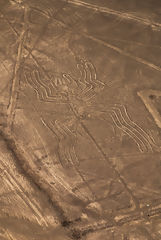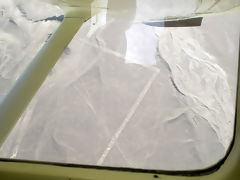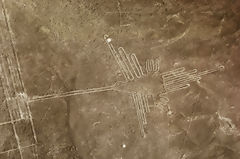 |
Associated pages: |
 Just before reaching the small town of Nazca, you cross a vast desert plain, similar to the Tademait plain in the Sahara. It was in this arid pampa that strange figures were discovered in 1939, probably drawn between 300 and 900 AD. Unfortunately, the Pan-American Highway cuts through this area. These gigantic designs, drawn or engraved directly on the desert floor of Nazca, stretch across dozens of kilometers. Surrounding these lines are stylized representations of animals such as the monkey, spider, and hummingbird. These figures climb cliffs or cross mountains without their shapes being altered. Some lines resemble deep paths that can reach more than 3 meters in width. To this day, archaeologists are still debating the exact purpose of these figures. Some believe they were part of a complex astronomical calendar, while others suggest they had a ritual or religious significance.
Just before reaching the small town of Nazca, you cross a vast desert plain, similar to the Tademait plain in the Sahara. It was in this arid pampa that strange figures were discovered in 1939, probably drawn between 300 and 900 AD. Unfortunately, the Pan-American Highway cuts through this area. These gigantic designs, drawn or engraved directly on the desert floor of Nazca, stretch across dozens of kilometers. Surrounding these lines are stylized representations of animals such as the monkey, spider, and hummingbird. These figures climb cliffs or cross mountains without their shapes being altered. Some lines resemble deep paths that can reach more than 3 meters in width. To this day, archaeologists are still debating the exact purpose of these figures. Some believe they were part of a complex astronomical calendar, while others suggest they had a ritual or religious significance.
The Nazca priests were excellent astronomers. It is believed today that these drawings are representations of figures formed by stars. Some of these figures appear in the sky at specific times of the year, corresponding to key agricultural periods such as sowing, rain, and harvests. Depending on these celestial alignments, Nazca farmers could organize their activities. Fascinatingly, each design has an access path that allows people to enter the area without stepping on the lines. The unit of measurement used was the human forearm (32.5 cm), and the number 8 was considered sacred to them (as in the case of the spider, which has 8 legs). Recent research has revealed that some of the lines were also aligned with natural phenomena such as the solstice and equinox, reinforcing the idea that the lines played a role in the agricultural calendar.
 However, the most mysterious feature remains the gigantic straight lines that overlap. Some ethnologists, like Robert Charroux, have put forward bold theories suggesting that these lines were created by extraterrestrials. However, the most serious studies indicate that these perfectly straight lines, some of which extend for up to 10 km, were not landing strips for spacecraft. Instead, they were used to align the Sun, Moon, and stars to calculate the seasons. Other recent studies suggest that the lines may have served as ceremonial routes or sacred paths, used in rituals held at specific times.
However, the most mysterious feature remains the gigantic straight lines that overlap. Some ethnologists, like Robert Charroux, have put forward bold theories suggesting that these lines were created by extraterrestrials. However, the most serious studies indicate that these perfectly straight lines, some of which extend for up to 10 km, were not landing strips for spacecraft. Instead, they were used to align the Sun, Moon, and stars to calculate the seasons. Other recent studies suggest that the lines may have served as ceremonial routes or sacred paths, used in rituals held at specific times.
 María Reiche (1903, Germany – 1998, Peru), known as "The Lady of Nazca," was one of the leading researchers of the lines. Although she passed away over 25 years ago, her legacy continues to inspire many scholars. She arrived in Nazca in 1946 almost by chance and never left the region. It is thanks to her that we have the most serious interpretations of the lines. She lived year-round at the Hotel de Turistas at the entrance of the city, with her stay covered by the Peruvian government in recognition of her research. An interesting anecdote: all of the Nazca figures have four fingers… just like María Reiche. Today, the María Reiche Museum, located near Nazca, displays her research tools and documents, allowing visitors to learn more about the life of this extraordinary woman.
María Reiche (1903, Germany – 1998, Peru), known as "The Lady of Nazca," was one of the leading researchers of the lines. Although she passed away over 25 years ago, her legacy continues to inspire many scholars. She arrived in Nazca in 1946 almost by chance and never left the region. It is thanks to her that we have the most serious interpretations of the lines. She lived year-round at the Hotel de Turistas at the entrance of the city, with her stay covered by the Peruvian government in recognition of her research. An interesting anecdote: all of the Nazca figures have four fingers… just like María Reiche. Today, the María Reiche Museum, located near Nazca, displays her research tools and documents, allowing visitors to learn more about the life of this extraordinary woman.
A tip before flying over the lines: do not eat anything before the flight... you might regret it! The plane flies at 300 meters above ground at a speed of 220 km/h, so it is recommended to use a camera with a fast shutter speed and a polarizing filter to avoid reflections on the windows. The recommended lenses are 50 mm and 135 mm. Today, several companies offer tourist flights over the Nazca lines, and it is recommended to book in advance, especially during high season (from May to October).
The climate in this region is warm and dry all year round, making it an ideal destination at any time. In addition to the famous lines, visitors can explore other nearby points of interest. One of the most impressive is the Chauchilla Cemetery, where well-preserved pre-Hispanic mummies can be seen. The ancient aqueducts of Cantalloc, showcasing the Nazca people's advanced hydraulic knowledge, are also worth visiting. Tourists can also visit local artisan workshops to see traditional ceramics being made and gold being worked, following ancestral techniques passed down through generations. Finally, no visit to Nazca would be complete without a stop at the María Reiche Planetarium, which offers detailed explanations of the astronomical theories related to the lines and an immersive experience under the desert’s starry sky.